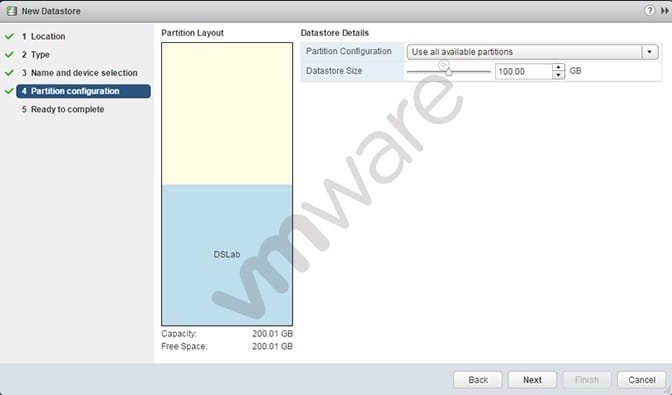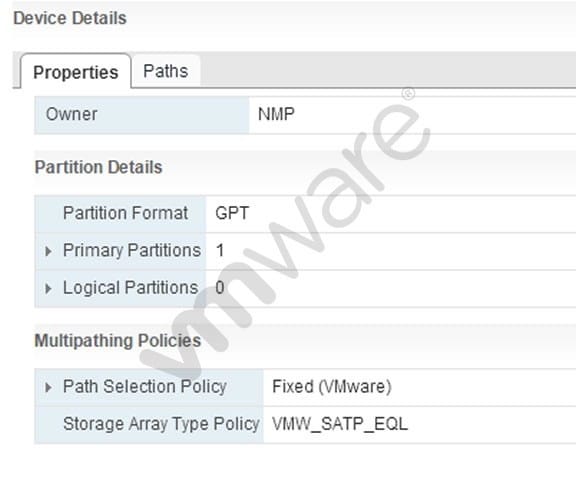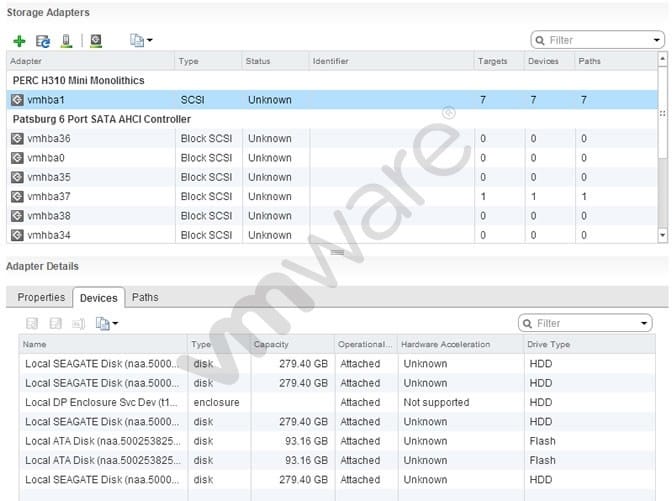Exam Details
Exam Code
:2V0-621DExam Name
:VMware Certified Professional 6 – Data Center Virtualization Delta BetaCertification
:VCP6-DCVVendor
:VMwareTotal Questions
:245 Q&AsLast Updated
:May 06, 2025
VMware VCP6-DCV 2V0-621D Questions & Answers
-
Question 161:
An administrator observes that virtual machine storage activity on an ESXi 6.x host is negatively affecting virtual machine storage activity on another host that is accessing the same VMFS Datastore. Which action would mitigate the issue?
A. Enable Storage IO Control.
B. Configure Storage DRS.
C. Enable the Dynamic Queue Depth Throttling option.
D. Configure the Disk.SchedNumReqOutstanding parameter.
-
Question 162:
Which two statements are true regarding VMFS3 volumes in ESXi 6.x? (Choose two.)
A. Creation of VMFS3 volumes is unsupported.
B. Upgrading VMFS3 volumes to VMFS5 is supported.
C. Existing VMFS3 volumes are unsupported.
D. Upgrading VMFS3 volumes to VMFS5 is unsupported.
-
Question 163:
Refer to the Exhibit.

What will be created upon completion of the steps in this wizard?
A. 100GB VMFS5 datastore with free space available for expansion
B. 100GB VMFS5 datastore with free space available for a second datastore
C. 100GB VMFS3 datastore
D. 200.01 GB VMFS5 datastore
-
Question 164:
Refer to the Exhibit.

An administrator wishes to provide Load Balanced I/O for the device shown in the Exhibit. To meet this requirement, which setting should be changed?
A. Storage Array Type Policy = VMW_NMP_RR
B. Path Selection Policy = Round Robin (VMware)
C. Storage Array Type Policy = VMW_SATP_RR
D. Path Selection Policy = MRU (VMware)
-
Question 165:
Refer to the Exhibit.

The list of devices attached to vmhba1 will be the basis for configuring a VMware Virtual SAN using Manual Mode. Based on the exhibit, which two combinations of devices should be used to create Disk Group(s)? (Choose two.)
A. One Disk Group with one Flash Drive and three HDDs
B. Two Disk Groups with one Flash Drive and two HDDs each
C. One Disk Group with one Flash Drive and four HDDs
D. Two Disk Groups with two Flash Drives and four HDDs each
-
Question 166:
Refer to the Exhibit.

What will be the result of selecting the highlighted device?
A. Datastore will grow up to 200.01GB using the remaining free space on the device.
B. Datastore will add 200.01GB by adding the device as a second extent.
C. The device size can be expanded to be larger than 200.01 GB in size.
D. The device is not suitable for this operation.
-
Question 167:
Refer to the Exhibit.

An administrator is using the esxtop command to troubleshoot storage performance issues on a virtual machine. The esxtop capture is shown in the Exhibit. Based on the exhibit, which two statements are true? (Choose two.)
A. The iSCSI device is experiencing high latency.
B. The ESXi kernel is experiencing high latency.
C. The Guest OS is experiencing high latency and response time.
D. The NFS device is experiencing high latency.
-
Question 168:
What are two use cases for Fibre Channel Zoning in a vSphere environment? (Choose two.)
A. Increases the number of targets presented to an ESXi host.
B. Controls and isolates paths in a fabric.
C. Controls and isolates paths to an NFS share.
D. Can be used to separate different environments.
-
Question 169:
Which two considerations should an administrator keep in mind when booting from Software Fiber Channel over Ethernet (FCoE)? (Choose two.)
A. Software FCoE boot configuration can be changed from within ESXi.
B. Software FCoE boot firmware cannot export information in FBFT format.
C. Multipathing is not supported at pre-boot.
D. Boot LUN cannot be shared with other hosts even on shared storage.
-
Question 170:
Which two tasks does the Pluggable Storage Architecture (PSA) perform? (Choose two.)
A. Handles I/O queueing to the logical devices.
B. Handles physical path discovery, but is not involved in the removal.
C. Handles physical path discovery and removal.
D. Handles I/O queueing to FC storage HBAs.
Related Exams:
Tips on How to Prepare for the Exams
Nowadays, the certification exams become more and more important and required by more and more enterprises when applying for a job. But how to prepare for the exam effectively? How to prepare for the exam in a short time with less efforts? How to get a ideal result and how to find the most reliable resources? Here on Vcedump.com, you will find all the answers. Vcedump.com provide not only VMware exam questions, answers and explanations but also complete assistance on your exam preparation and certification application. If you are confused on your 2V0-621D exam preparations and VMware certification application, do not hesitate to visit our Vcedump.com to find your solutions here.